The Folium of Descartes is given by the
equation ![]() . Picture:
. Picture:
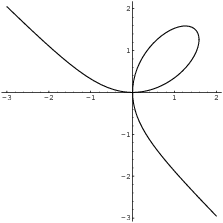
The graph consists of all points ![]() which satisfy the equation. For example,
which satisfy the equation. For example, ![]() is on the graph, because
is on the graph, because ![]() ,
, ![]() , satisfies the equation.
, satisfies the equation.
Observe, however, that the graph is not the graph of a function. Some values of x give rise to multiple values for y. (Geomtrically, this means you can draw vertical lines which hit the graph more than once.)
Moreover, it would be difficult to solve the equation for y in terms of x (unless you happen to know the general cubic formula).
However, small pieces of the graph do look like function
graphs. You only need to be careful not to take a piece which is so
large that it violates the vertical line criterion. For such a piece,
the equation defines a function ![]() implicitly.
"Implicitly" means that y may not be solved for in terms of
x, but a given x still "produces" a unique y.
implicitly.
"Implicitly" means that y may not be solved for in terms of
x, but a given x still "produces" a unique y.
On such a small piece of the graph, it would make sense to ask for
the derivative ![]() . Since it's difficult to solve
for y, it's not clear how to compute the derivative.
. Since it's difficult to solve
for y, it's not clear how to compute the derivative.
The idea is to differentiate the equation as is, making
careful use of the Chain Rule. This produces another equation, from
which you can get ![]() (perhaps implicitly as well).
(perhaps implicitly as well).
Differentiate ![]() term-by-term with
respect to x. First, the derivative of
term-by-term with
respect to x. First, the derivative of ![]() with respect to x is
with respect to x is ![]() :
:
![]()
The derivative of ![]() with respect to
y would be
with respect to
y would be ![]() , but I'm differentiating
with respect to x, so I use the Chain Rule. Differentiate the outer
(cube) function, holding the inner function (y) fixed. Then
differentiate the inner function. I obtain
, but I'm differentiating
with respect to x, so I use the Chain Rule. Differentiate the outer
(cube) function, holding the inner function (y) fixed. Then
differentiate the inner function. I obtain
![]()
Finally, differentiate the right side ![]() . The 3 is constant, but
. The 3 is constant, but ![]() is a product: Use the Product Rule.
Remember, however, that the derivative of the second factor (y) is
is a product: Use the Product Rule.
Remember, however, that the derivative of the second factor (y) is
![]() !
!
![]()
I can solve this equation for ![]() :
:
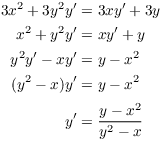
This may seem strange --- I've found ![]() in terms of y --- but I can use this expression for
the derivative as I normally would.
in terms of y --- but I can use this expression for
the derivative as I normally would.
For example, I'll find the values of x where the graph has a
horizontal tangent. As usual, set ![]() . I get
. I get ![]() , so
, so ![]() . Plug this back into the original equation
(because I'm looking for points on this curve):
. Plug this back into the original equation
(because I'm looking for points on this curve):
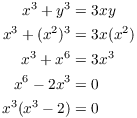
Therefore, ![]() or
or ![]() .
.
Example. Find the equation of the tangent line to
![]()
Differentiate the equation implicitly:
![]()
Since I have a point to plug in, I don't solve this equation for ![]() . Instead, I plug the point in first, then solve for
. Instead, I plug the point in first, then solve for
![]() . Set
. Set ![]() and
and ![]() :
:

The tangent line is
![]()
You can see that the rule of thumb is: To differentiate a
y-expression, differentiate it "like usual", but tack on a
![]() . The
. The ![]() comes from the Chain Rule. Thus:
comes from the Chain Rule. Thus:
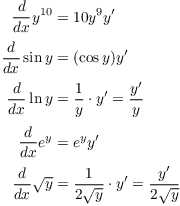
Example. Find the equation of the tangent line to
![]()
Differentiate implicitly:
![]()
Set ![]() and
and ![]() and solve for
and solve for ![]() :
:

The tangent line is
![]()
Example. Find the equation of the tangent line to
![]()
Differentiate implicitly:
![]()
Set ![]() and
and ![]() and solve for
and solve for ![]() :
:
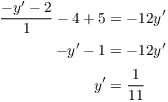
Therefore, the tangent line is
![]()
Example. Find the equation of the tangent line to
![]()
Differentiate implicitly:
![]()
Set ![]() and
and ![]() and solve for
and solve for ![]() :
:
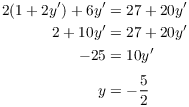
Therefore, the tangent line is
![]()
Example. Find the points on the following curve where the tangent line is horizontal:
![]()
Differentiate implicitly:
![]()
I want the horizontal tangents, so set ![]() and solve for x:
and solve for x:

To get the y-coordinates, plug ![]() into the original equation and solve for y:
into the original equation and solve for y:

This gives ![]() and
and ![]() .
.
The points are ![]() and
and ![]() .
.![]()
Example. The inverse
tangent function ![]() satisfies
satisfies
![]()
![]()
It is the inverse function to the tangent function: roughly, a function which "undoes" the effect of the tangent function.
Use implicit differentiation to compute the derivative of ![]() .
.
Start with ![]() and take the tangent
of both sides:
and take the tangent
of both sides: ![]() . Now differentiate
implicitly:
. Now differentiate
implicitly:

I want to express the right side in terms of x. Now ![]() means that I have the following triangle:
means that I have the following triangle:
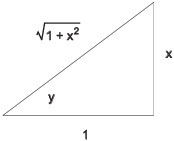
Therefore, ![]() , and
, and
![]() . Hence,
. Hence,
![]()
Example. Find ![]() at
at ![]() for
for
![]()
First, I'll differentiate implicitly and find ![]() . Then I'll differentiate implicitly a second time to
find
. Then I'll differentiate implicitly a second time to
find ![]() .
.
Differentiate implicitly:
![]()
Plug in ![]() and
and ![]() and solve for
and solve for ![]() :
:

Next, differentiate (*) implicitly:
![]()
Note that I used the Product Rule to differentiate the term ![]() .
.
Now plug in ![]() ,
, ![]() , and
, and ![]() and
solve for
and
solve for ![]() :
:
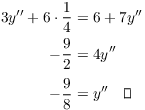
Copyright 2018 by Bruce Ikenaga